 |
-
Click the Isoparametric Curve icon:

| The Isoparametric curve dialog box
appears, the Support field is selected. |
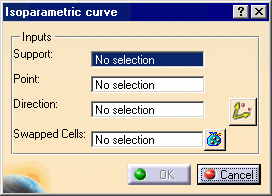 |
|
The Isoparametric curve dialog box
displays the isoparametric curve inputs:
-
Support defines that isoparametric
curve support can help you to:
-
Point defines the isoparametric
curve point.
-
Direction defines the isoparametric
curve direction.
-
Select the direction by clicking a
geometrical element.
-
Create the direction using the contextual
staked commands, for this right-click in the Direction
field, see Creating Lines
and Creating
Intersections:
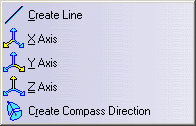
-
Swapped Cells displays the cell
where the isoparametric propagation direction has been swapped from the
nearest isoparametric propagation direction to the farthest isoparametric
propagation direction. This functionality makes sense in case of multiple
surfaces support.
|
-
Select Join.1 as curve support.
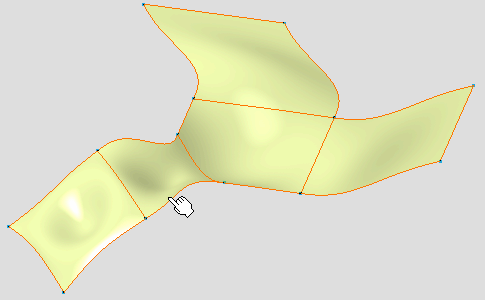 |
| The Point field is highlighted in the
Isoparametric Curve dialog box. |
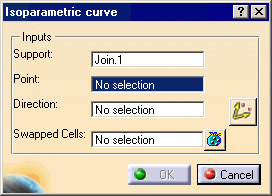 |
| The isoparametric curve is previewed on the
surface when you move the cursor. |
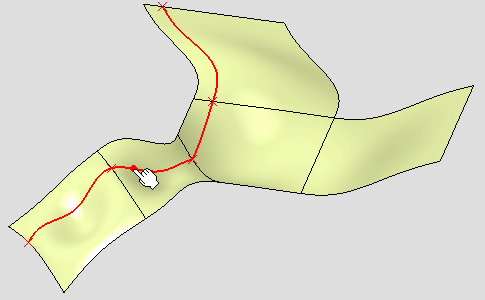 |
-
Click to indicate where to create the isoparametric
curve.
 |
- The isoparametric curve is pre-created, a manipulator is
displayed.
In case of multiple surfaces support, the
selected surface is the reference cell.
- You can move along the curve using the manipulator arrows.
In case of multiple surfaces support you can only move the
manipulator inside the reference cell.
|
|
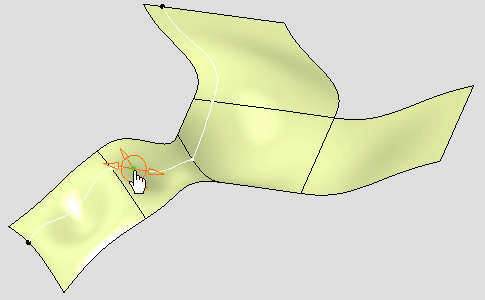 |
 |
A contextual menu is available when you
right-click the manipulator: |
|
 |
- Edit: this command allows you to
define the isoparametric curve according to its parameters.
- Keep this point: this command
allows you to create the point where you clicked.
- Swap UV: this command allows you to
swap U and V parameter values.
This command is also available in the
Isoparametric curve
dialog box when you click the Swaps Curve Direction icon:

|
-
Select Swap UV from the contextual menu.
| The isoparametric curve parameters are swapped. |
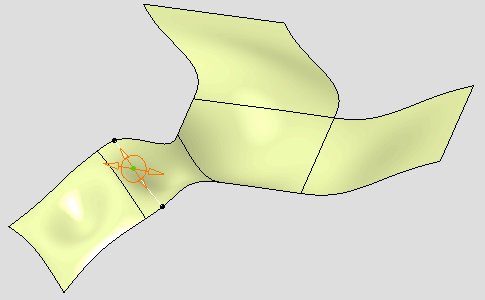 |
-
Re-select Swap UV from the contextual menu.
-
Select Keep this point from the contextual
menu.
| The point is created. |
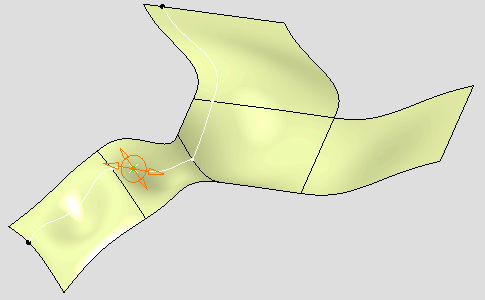 |
| The Point and Direction
fields are filled according to the selection in the Isoparametric
Curve dialog box. |
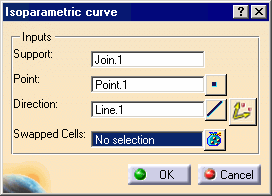 |
| Point and Direction are
editable from the Isoparametric Curve dialog box using icons at
the right of each field: |
-
Select Edit from the contextual menu.
| The Tuner dialog box appears. |
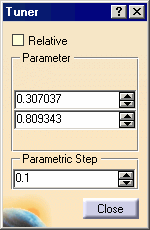 |
-
Select Relative option in the Tuner
dialog box.
| The relative origin of the curve is displayed on
the curve support. |
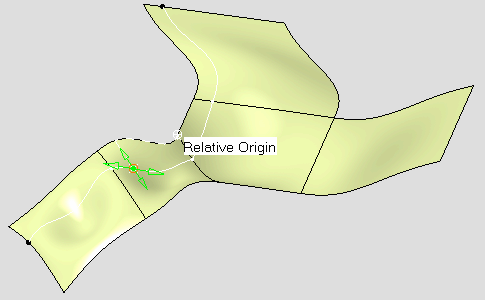 |
 |
The Tuner dialog box is modified:
- True Length option is displayed.
- Reset Origin button is displayed.
|
|
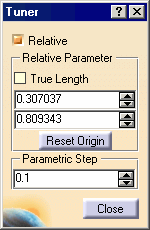 |
-
Click Reset Origin in the Tuner
dialog box.
| The relative origin of the curve is reset from
the curve point. |
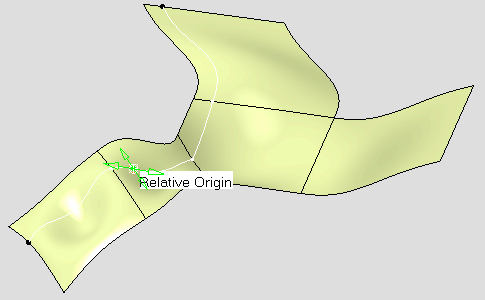 |
| The Tuner dialog box displays the new
origin values. |
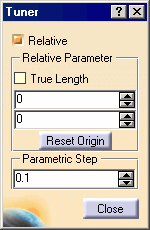 |
-
Click Close in the Tuner dialog
box.
-
Select the surface as shown.
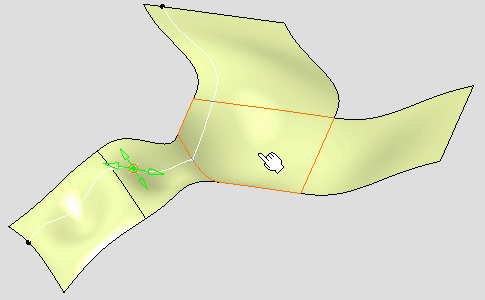 |
| The isoparametric propagation direction has been
swapped from the nearest isoparametric propagation direction to the
farthest isoparametric propagation direction in the selected cell. |
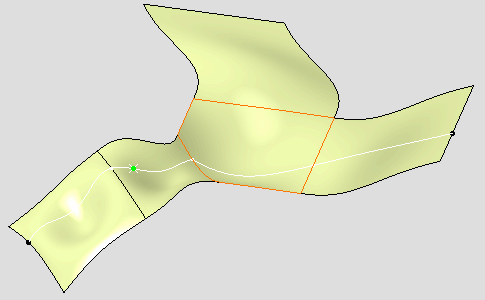 |
| The selected surface has been added to the Swapped Cells field. |
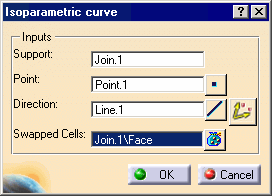 |
-
Click Swapped Cells List icon:

| The Swapped Cells List dialog box
appears. You can manage inside this dialog box the swapped cells: remove or
replace. |
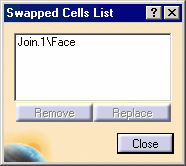 |
-
Click Close in the Swapped Cells List
dialog box.
-
Click OK in the Isoparametric curve
dialog box.
| The isoparametric curve is created. |
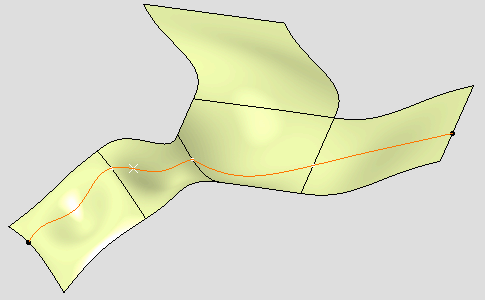 |
| The Isoparameter.1 object is created
in the specification tree. |
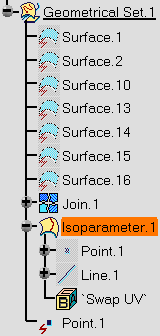 |
 |
A point and line have been created:
- The point corresponds to the cursor location
when you define the curve.
- The line corresponds to the curve orientation
when you define the curve.
|
|
| The Swap UV parameter contains the
information indicating that the curve has been swapped. |
About Editing Isoparametric Curve
You can edit an existing isoparametric curve using the contextual
menu from the Isoparameter.n object command
(specification tree or geometrical object), and selecting the
Definition contextual command:
- You can change the curve support by selecting the
Support field in the Isoparametric Curve
dialog box that appears, then the new support.
- You can modify the curve parameters in the same way as
during its creation
|
![]()